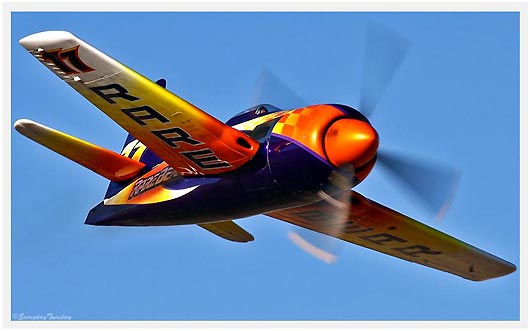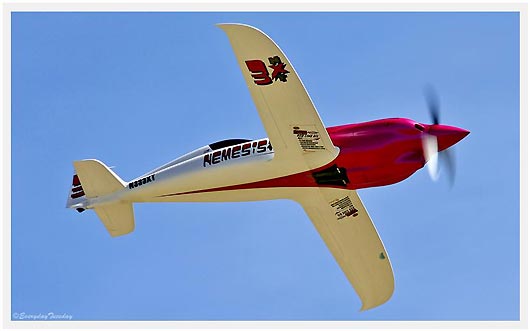Airfoil Shapes In The Fast-Lane World Of The Reno Air Races
 Thursday, September 9, 2010 at 04:42PM
Thursday, September 9, 2010 at 04:42PM 
(4 pix)
I'm guessing the best way to go fast and win at Reno is horsepower under the hood. However, drag-reduction thru proper design and great attention to detail is not only a major part of any winning team, but it’s probably a large part of what makes this game so much fun for those who get to play it.
I thought it would be interesting to look at the airfoils used on some of the fastest propeller driven aircraft that turn circles in the desert in mid September. The image above shows three very different airfoils that fairly accurately represent the three wing cross sections of the airplanes pictured below. Researching the exact airfoils via the internet can be difficult, but I’m confident the samples shown pretty closely identify the shapes actually in use.
 P-51 Mustang 'Strega': 1st place 'Unlimiteds' at Reno 2009 (photo: Everyday Tuesday)
P-51 Mustang 'Strega': 1st place 'Unlimiteds' at Reno 2009 (photo: Everyday Tuesday)
Let’s start with the North American P-51 Mustang, one of the most popular WWII aircraft used in the Unlimited Class of racers. In the big Championship race on the last day of Reno 2009, it was two P-51’s, Strega and Voodoo that were dominating, but Voodoo had a race ending engine problem before it was over, which opened the door for Rare Bear to finish second behind Strega. All three of these airplanes were running near 500 mph in that race. No matter how you slice it (pun intended), moving a wing thru the air that fast has to be some interesting aerodynamics.
The airfoil shape on the P-51 is definitely different than most of what was seen back in the 1940’s. Just to clarify, normally I’d identify the name of the airfoil right now, but that’s been a bit confusing in my research, so I’m gonna leave this one without a name. But if you’ve ever looked at a P-51 wing tip very closely, you’ll recognize that unique shape as seen above.
You may have heard that the P-51 was the first airplane to use a ’laminar flow’ airfoil. A little deeper research actually identifies the B-24 as the first to use a laminar flow airfoil (say what?), but that doesn’t sound nearly as romantic, so go ahead and believe what you want. Regardless, the P-51 does indeed have an airfoil that in theory has the ability for the air to remain smooth and stable as far back as 60% of the distance from the leading edge to the trailing edge. And to tell the whole story, that's significantly further than the 30% of the B-24 airfoil, and for comparison, a ’standard’ airfoil is usually less than 20%.
The big problem with most applications of laminar flow airfoils in the real world is that things like rivets, skin irregularities from manufacturing and wear, access doors, bugs or anything else that disturbs the perfectly smooth shape that was intended, will prevent the drag-reducing laminar flow from showing up. But in theory, a wing section that has its thickest point much farther aft than a standard airfoil is far better at keeping the airflow smoother, longer. I’d have to say that these shapes are beautiful to look at too. For example, compare the shape of the P-51 airfoil to that of the F-8 Bearcat. You might know I’m a huge Bearcat fan, but the shape of the P-51 cross section is way cooler looking to me than the one on the Bearcat.
 F-8 Bearcat 'Rare Bear': 2nd place 'Unlimiteds' at Reno 2009 (photo: Everyday Tuesday)
F-8 Bearcat 'Rare Bear': 2nd place 'Unlimiteds' at Reno 2009 (photo: Everyday Tuesday)
The F-8 Bearcat airfoil is far more like the shapes we typically associate with a wing. Grumman used the NACA 230 series on the F-8, and again, the specifics are a little hard to confirm, but at the wing root it looks like they used the NACA 23018 and at the tip it’s 23009. The ‘18’ and ‘09’ numbers at the end of the designation relate to the thickness of the section. At the root it’s 18% (comparing the height of the section to it’s length from leading edge to trailing edge), and at the tip just 9% thick. What I’ve shown in the picture above is actually the NACA 23012 airfoil, which would be somewhere in between the root and the tip. So, a little outboard of half way out the wing, this is what the airfoil looks like.
The 23012 is actually a pretty popular airfoil. I remember learning about it years ago when I found out that it’s the reason a Taylorcraft is a noticeably faster airplane than its cousin the Piper Cub, which has the USA 35B section. For some reason, many people think the Cub had a Clark Y, but it was actually the very similar USA 35B. Anyway, the RV-4, 6, 7, and 8 all run a 13.5% version (23013.5) of the 230 series too. So, while the Bearcat’s wing section isn’t all jazzy-cool looking like that of the P-51, it’s still a shape that’s known for being on the good side of the efficiency curve. Of course, when in doubt, it never hurts to have a 4,000 hp radial engine pulling you thru the sky too!
 Nemesis NXT: 1st place 'Super Sport' at Reno 2009 (photo: Everyday Tuesday)
Nemesis NXT: 1st place 'Super Sport' at Reno 2009 (photo: Everyday Tuesday)
But then we have an airplane like the Sharp Nemesis NXT which has kinda shattered our idea of how fast an airplane can go without having 2,000 - 4,000hp hanging off the front end. Tho the airplane has the smallish Lycoming TIO-540 engine, you can be sure it’s making way more power than you’d find in any production airplane. Instead of the typical 350+ hp, it’s more likely double that in the NXT. But it seems safe to say that it’s still well under 1,000 hp. So, Jon Sharp has proven by his performance the last two years at Reno that the NXT is a 400+ mph airplane (2009 qualifying: 412+ mph)… and it’s doing it on less than 1,000 hp! This is some seriously impressive stuff to say the least.
The shape of the sample cross section above for the Nemesis NXT may have a lot to do with this dramatic performance they’ve achieved. I have pictured the NASA NLF-0414F section, which my research indicates should be a good representation of the actual airfoil used. Thru advanced wind tunnel testing and super-computer crunching, we seem to be manipulating the details of airfoil design these days with some great results. But some of this gain is also likely coming from the use of the composite materials. If you’ve ever seen the wing on either the Nemesis or Relentless Racing Teams NXT’s, you’ll better understand the difference between laminar flow theory and practical application. The glass-smooth contour that the composites achieve, when compared to the somewhat wavy and distorted metal structures of airplanes like the P-51, really comes into play. Key point here: it’s not necessarily the actual ’smoothness’ of the surface, but the absence of shape irregularities. When the contour matches the desired shape to within thousands of an inch, everything that the data claimed about performance can be achieved. I understand that the winning unlimited teams do ‘contour’ the wings of their old wavy metal Warbirds by adding filler etc, but I’m not sure they’re ever able to achieve the same results.
So, there’s a look at some of the airfoil details that may help shape the winners and losers at Reno this year. If I’m able to make it out there next week, I’ll be sure to get some detailed pix to go with this info, and also see if I can learn more interesting info of where airfoil design might be heading in the future.
BTW, if you didn’t know, Jon and Patricia Sharp (team Nemesis) are taking a break this year and will not be racing at Reno. This swings the door wide open for Kevin Eldredge and his Relentless NXT to chase down a championship trophy. However, potential gremlins of despair, and a few other racers are gonna be right there to make it a lot like work for Kevin and his crew. I’d especially keep my eye on Mike Dacy and his 'egg-with-wings' modified Questair Venture to be challenging Kevin big time. And there may be a few surprises this year too… it should be a very interesting year in the Super Sport class. In reality, it’ll be a very exciting year in all the classes, cuz that’s the nature of the fastest motorsport in the world - the Reno Air Races!
2010 Reno Air Races September 15-19
More great aviation pix from Everyday Tuesday
 Martt |
Martt |  5 Comments |
5 Comments |  Bearcat,
Bearcat,  Nemesis,
Nemesis,  P-51,
P-51,  Racing,
Racing,  Rare Bear,
Rare Bear,  Reno,
Reno,  aerodynamics
aerodynamics  Email Article
Email Article 













































































Reader Comments (5)
Great post Mart, I have an affinity for these planes and everything speed. :)
i believe the new airfoils are still lacking in initial design simplicity ..the camber should be as forward as possible for efficiency and as minimum as possible and the thickness should be as thick as possible for lowest wetted area but compremised with profile drag and as far to the rear as possible for longest lead up percentage of boundry layer control under pressure for laminar flow and inertial response till the flow reaches maximum height of the airfoil and then viscicity takes over with turbulent flow down to the trailing edge and the nose pressure should equal the tail pressure for zero drag and the air should stop at the nose momentarily and stop at the tail to equal this phenominae so there is no diown wash which cause suction backwards drag basicaly ..skeatesy1
I build rc wings out of epp foam and am going to try the more symmetrical and rearward bump to see if there is any difference in the more Bearcat style airfoil I currently use.
I'm surprised the P-51 airfoil isn't specifically described as a NACA type, although it looks like a NACA 65 2-015 which has laminar flow up to about 40% of the chord from the leading edge. Polars to accompany the cross-section view detailing the drag bucket and coefficient of lift would be great right along with graphs delineating Reynolds numbers (size and speed of airfoil). Anyway, thanks for the info.
The P-51 airfoil through D/K was NACA/NAA 45-100. The F/G/H/J was a NACA 66 series